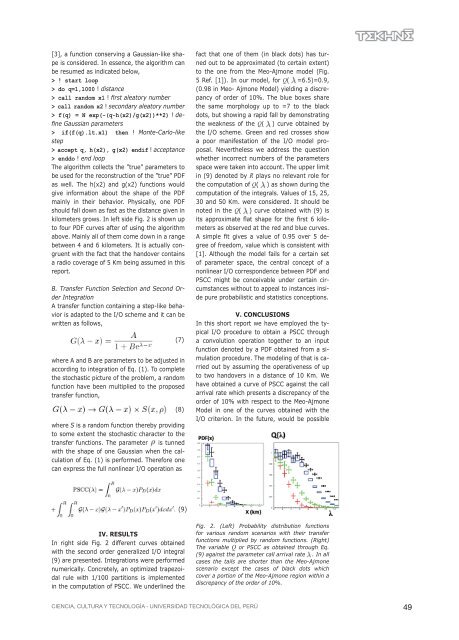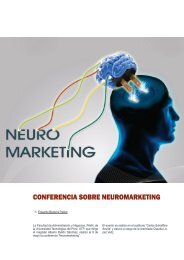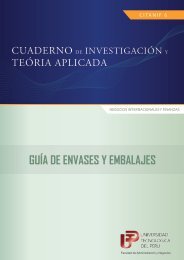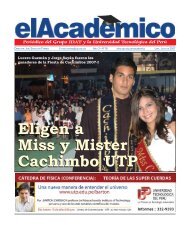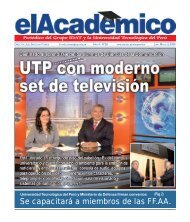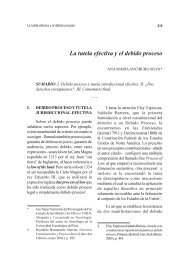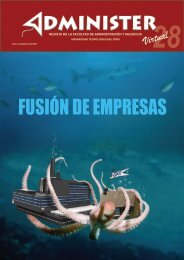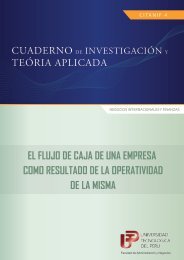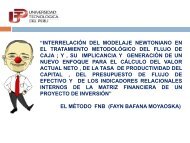Descargar - UTP
Descargar - UTP
Descargar - UTP
Create successful ePaper yourself
Turn your PDF publications into a flip-book with our unique Google optimized e-Paper software.
[3], a function conserving a Gaussian-like shape<br />
is considered. In essence, the algorithm can<br />
be resumed as indicated below,<br />
> ! start loop<br />
> do q=1,1000 ! distance<br />
> call random x1 ! first aleatory number<br />
> call random x2 ! secondary aleatory number<br />
> f(q) = N exp(-(q-h(x2)/g(x2))**2) ! define<br />
Gaussian parameters<br />
> if(f(q).lt.x1) then ! Monte-Carlo-like<br />
step<br />
> accept q, h(x2), g(x2) endif ! acceptance<br />
> enddo ! end loop<br />
The algorithm collects the ”true” parameters to<br />
be used for the reconstruction of the ”true” PDF<br />
as well. The h(x2) and g(x2) functions would<br />
give information about the shape of the PDF<br />
mainly in their behavior. Physically, one PDF<br />
should fall down as fast as the distance given in<br />
kilometers grows. In left side Fig. 2 is shown up<br />
to four PDF curves after of using the algorithm<br />
above. Mainly all of them come down in a range<br />
between 4 and 6 kilometers. It is actually congruent<br />
with the fact that the handover contains<br />
a radio coverage of 5 Km being assumed in this<br />
report.<br />
B. Transfer Function Selection and Second Order<br />
Integration<br />
A transfer function containing a step-like behavior<br />
is adapted to the I/O scheme and it can be<br />
written as follows,<br />
CIENCIA, CULTURA Y TECNOLOGÍA - UNIVERSIDAD TECNOLÓGICA DEL PERÚ<br />
(7)<br />
where A and B are parameters to be adjusted in<br />
according to integration of Eq. (1). To complete<br />
the stochastic picture of the problem, a random<br />
function have been multiplied to the proposed<br />
transfer function,<br />
(8)<br />
where S is a random function thereby providing<br />
to some extent the stochastic character to the<br />
transfer functions. The parameter is tunned<br />
with the shape of one Gaussian when the calculation<br />
of Eq. (1) is performed. Therefore one<br />
can express the full nonlinear I/O operation as<br />
(9)<br />
IV. RESULTS<br />
In right side Fig. 2 different curves obtained<br />
with the second order generalized I/O integral<br />
(9) are presented. Integrations were performed<br />
numerically. Concretely, an optimized trapezoidal<br />
rule with 1/100 partitions is implemented<br />
in the computation of PSCC. We underlined the<br />
fact that one of them (in black dots) has turned<br />
out to be approximated (to certain extent)<br />
to the one from the Meo-Ajmone model (Fig.<br />
5 Ref. [1]). In our model, for Q( =6.5)=0.9,<br />
(0.98 in Meo- Ajmone Model) yielding a discrepancy<br />
of order of 10%. The blue boxes share<br />
the same morphology up to =7 to the black<br />
dots, but showing a rapid fall by demonstrating<br />
the weakness of the Q( ) curve obtained by<br />
the I/O scheme. Green and red crosses show<br />
a poor manifestation of the I/O model proposal.<br />
Nevertheless we address the question<br />
whether incorrect numbers of the parameters<br />
space were taken into account. The upper limit<br />
in (9) denoted by R plays no relevant role for<br />
the computation of Q( ) as shown during the<br />
computation of the integrals. Values of 15, 25,<br />
30 and 50 Km. were considered. It should be<br />
noted in the Q( ) curve obtained with (9) is<br />
its approximate flat shape for the first 6 kilometers<br />
as observed at the red and blue curves.<br />
A simple fit gives a value of 0.95 over 5 degree<br />
of freedom, value which is consistent with<br />
[1]. Although the model fails for a certain set<br />
of parameter space, the central concept of a<br />
nonlinear I/O correspondence between PDF and<br />
PSCC might be conceivable under certain circumstances<br />
without to appeal to instances inside<br />
pure probabilistic and statistics conceptions.<br />
V. CONCLUSIONS<br />
In this short report we have employed the typical<br />
I/O procedure to obtain a PSCC through<br />
a convolution operation together to an input<br />
function denoted by a PDF obtained from a simulation<br />
procedure. The modeling of that is carried<br />
out by assuming the operativeness of up<br />
to two handovers in a distance of 10 Km. We<br />
have obtained a curve of PSCC against the call<br />
arrival rate which presents a discrepancy of the<br />
order of 10% with respect to the Meo-Ajmone<br />
Model in one of the curves obtained with the<br />
I/O criterion. In the future, would be possible<br />
Fig. 2. (Left) Probability distribution functions<br />
for various random scenarios with their transfer<br />
functions multiplied by random functions. (Right)<br />
The variable Q or PSCC as obtained through Eq.<br />
(9) against the parameter call arrival rate . In all<br />
cases the tails are shorter than the Meo-Ajmone<br />
scenario except the cases of black dots which<br />
cover a portion of the Meo-Ajmone region within a<br />
discrepancy of the order of 10%.<br />
49


